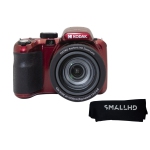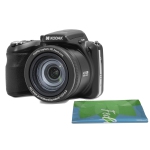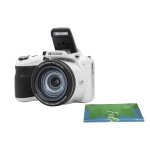Get professional results with a DSLR camera
Which DSLR camera is right for you? Superficially, they may look similar, including the ability to change lenses, but there’s a huge difference between entry-level, midrange and professional DSLR cameras.
Entry Level
For the beginner who’s stepping up from a point-and-shoot camera, an entry level DLSR is great introduction. Most of these cameras are equipped with APS-C or DX image sensors. Measuring approximately 24 mm x 16 mm, the sensors are smaller than the full frame versions found in professional DSLRs, but they are still a huge improvement. For example, the image sensors found in the latest smartphone cameras measure 5 mm x 6 mm.
A bigger image sensor doesn’t just mean more pixels in a photo, it means more light is captured for better results. Entry level DSLRs are great for capturing your family vacation and other special moments with more detail and accuracy than a pocket camera or your smartphone. You can add new lenses for enhanced capabilities, including telephoto zoom and they’re compatible with midrange and even professional DSLRs from the same company, so your investment isn’t lost should you choose to upgrade to a more capable camera.
Midrange
Midrange DSLRs are the sweet spot for many people. Most employ an APS-C or DX image sensor, but they offer greater performance and considerably more control over photographs. For example, compared to an entry level DSLR, a midrange model is likely to offer a faster shooting speed (more photos per second), a greater number of autofocus points, a larger and higher resolution display, increased ISO sensitivity range, a faster shutter speed and greater control over settings like flash, exposure and white balance.
Midrange DSLRs are an excellent choice for photography enthusiasts who enjoy taking pictures of landscapes and nature. They’re also a good choice for parents who want to take photos of their kids in action while playing sports.
Professional
Professional DSLRs are the pro grade cameras you see being used in studios, at concerts and at professional sporting events. The single biggest difference compared to entry level and midrange DSLRs is the move to a full frame or FX sensor.
An FX sensor measures a whopping 36 mm x 24 mm, giving it two and a half times the surface area of a DX sensor. That lets it replicate the experience of using 35 mm film, which is where it gets the “full frame” designation. That super-sized sensor means superior low light performance and 4K video capability. Professional DSLR cameras also offer a massive upgrade in shooting speed (a big win for sports and nature photography) and much more precise control over functions like focus modes, exposure, flash and white balance. They are usually equipped with high capacity battery packs and most can accommodate two memory cards. These cameras with their advanced features and full frame sensors are renowned for delivering premium results with incredible clarity, whether used for portraits or capturing live events.
Additional camera gear
Accessories for your DSLR will help you take your shots further. A camera bag is usually one of the best ways to protect and store your camera. Camera straps offers quick access and convenient carrying options for your DSLR. Extra memory cards, additional lenses, flashes, tripod, filters, extra batteries, and more offer you the freedom, security, and peace-of-mind to experiment and get creative with your photography without getting interrupted.
Want more info? Check out some of our resources:
Best camera kit for influencers
Should you buy a mirrorless camera, a DSLR or point and shoot camera?
How to master mobile photo editing for your DSLR photos






